Hope Tech 4 V4
Blister’s Measured Weight: 308 and 309 g (uncut standard hoses, no adapters or rotors)
MSRP: $265 per brake w/ standard hose, w/o rotors or adapters (braided stainless steel hose available for a $15 upcharge)
Bolted to: Nicolai G1 and BTR Ranger
Reviewer: 6’, 170 lbs / 183 cm, 77.1 kg
Test Locations: Washington
Test Duration: 4.5 months
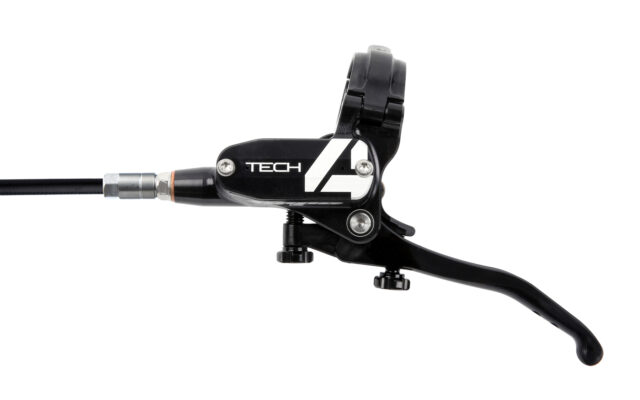
Intro
Hope has been making mountain bike disc brakes for just about as long as there have been mountain bike disc brakes, and they’ve recently given the core of their brake lineup a major overhaul, in the form of the new “Tech 4” generation. I already spoke about the changes in detail with Hope engineer, Sam Gibbs, back in Ep. 122 of Bikes & Big Ideas. But I’ve also now spent much of the summer bike season testing the most gravity-oriented brake of the bunch, the new Tech 4 V4, and I’ve come away impressed.
Design
Most of the updates to the Tech 4 lineup come at the lever end. And by that, I mean that the entire lever assembly has been completely redesigned from the prior Tech 3 generation. At the center of Hope’s goals for the redesign was an increase in power — which they claim is up 30% over the Tech 3 brakes — through a combination of increasing hydraulic and mechanical leverage ratio.
[If you want a more in-depth explanation of what all that means, check out the “Design” section of our Cascade Components North Fork brake caliper review. But in short, Hope has increased the mechanical advantage of the Tech 4 lever by both reducing the size of the master cylinder piston (to 9.5 mm in diameter, from 10 mm) and increasing the leverage of the lever blade itself.]
Hope’s longstanding tool-free reach and bite-point adjusters carry over largely unchanged from the Tech 3 brakes, though Hope does say that the exact leverage curve has been changed to provide more at the bite point. I’m on the record as finding contact-point adjustments to be not terribly useful since, as implemented on most brakes (the Magura MT7 HC3 being the only counterexample that I’m aware of), they simply make for a period of dead stroke in the lever throw before the brake starts building line pressure, but there’s one here if you want it.
Hope has made a number of refinements to the ergonomics and feel of the Tech 4 levers, including revising the seal design to reduce friction and adding cartridge bearings to the lever pivot with the same goal in mind. All of that allows Hope to use a lighter lever return spring in the new Tech 4 lever, which makes for a lighter lever feel and Hope says also helps reduce hand fatigue, especially on longer descents.
The Tech 4 levers are right- and left-side specific, but no matter which lever you order, the brakes ship with a full-length hose so there are no headaches in swapping hoses around, no matter which side of the bike you run the front and rear brakes. The standard hose option is a fairly typical plastic and kevlar affair; braided stainless steel lines are available for a $15 upcharge, and are said to offer a slightly firmer lever feel due to reduced expansion under pressure, at the cost of, well, cost, and a bit of weight. The Tech 4 brakes still use DOT fluid and are machined in Hope’s own facility in Barnoldswick, UK. Hope’s classic options for anodized colors (black, silver, blue, red, orange, and purple) carry over as well, though the caliper and lever body are now offered in black or silver only, and the colored bits are limited to accent pieces.
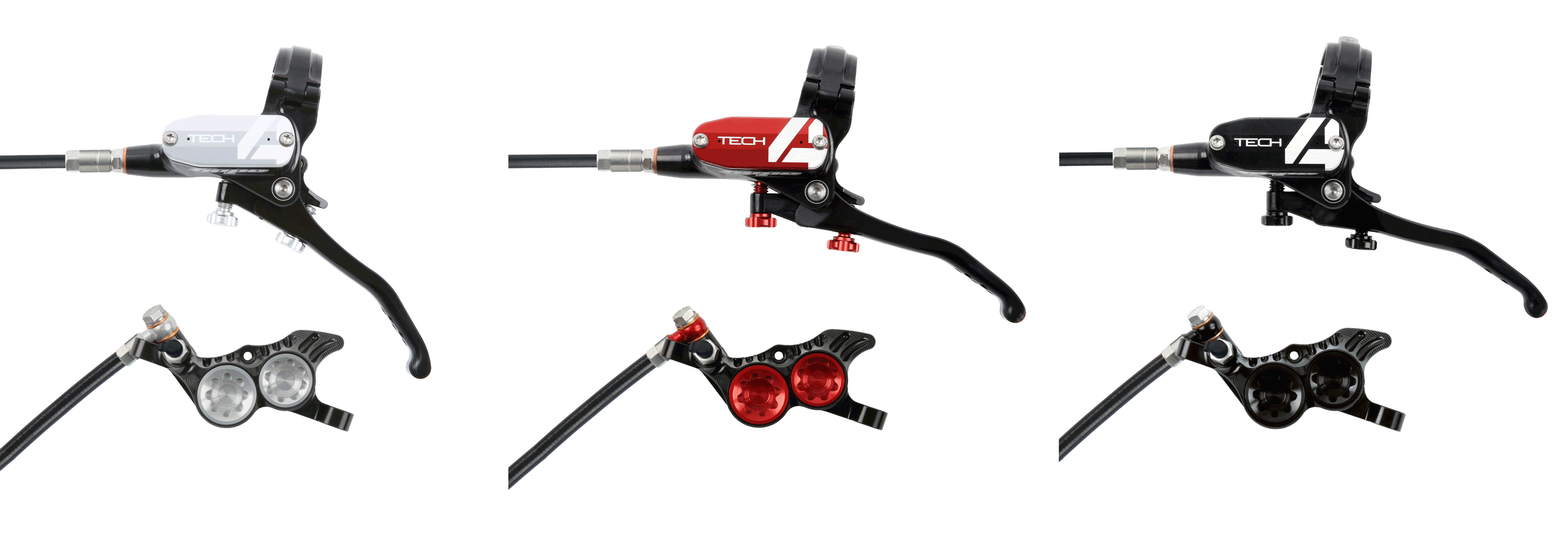
Due to the revised shape of the Tech 4 lever body, the bleed kit for the Tech 4 levers is different from the earlier Tech 3 version, though it operates on the same principle, by replacing the reservoir cap with a separate version that includes a fitting for a funnel and letting fluid out through a bleed nipple at the caliper. It is possible to bleed the Tech 4 brakes without a bleed kit by simply topping up the lever reservoir carefully and regularly, but doing so is a bit slower and takes some extra care.
Hope offers the Tech 4 lever with four different caliper options: the X2, E4, V4, and Trial Zone. The X2 is a two-piston model intended for XC use; the E4 is a four-piston Trail bike option, and the V4 is a four-piston Enduro / DH brake. The Trial Zone is a two-piston Trials brake, meant to offer a ton of clamping power for wheel-locked Trials moves.
All four calipers use one-piece construction, and while they haven’t been overhauled as significantly as the Tech 4 lever, all of the versions get new hybrid pistons, which feature primarily phenolic resin construction, but with a stainless steel sleeve around the outside sealing surface. The Tech 3 pistons were entirely phenolic, with the goal of minimizing heat transfer through the pistons into the brake fluid, but the new hybrid pistons are meant to preserve most of that insulation while featuring a harder, smoother sealing surface for reduced friction, lower maintenance, and fewer chances of leaky or sticky pistons.
Each caliper version gets its own dedicated pad shape to match the respective piston size and count. And speaking of those pads, Hope has revised their brake pad compound offerings, including a new “Race” version that ships as standard in all of the Tech 4 brakes.
Hope has a brake selection guide that provides suggestions on what brake model and rotor size is appropriate for different types of riding and combined rider + bike system weights. I took its advice and have been testing the V4 both with dual 203 mm rotors, and a 220 mm front / 203 mm rear combination.
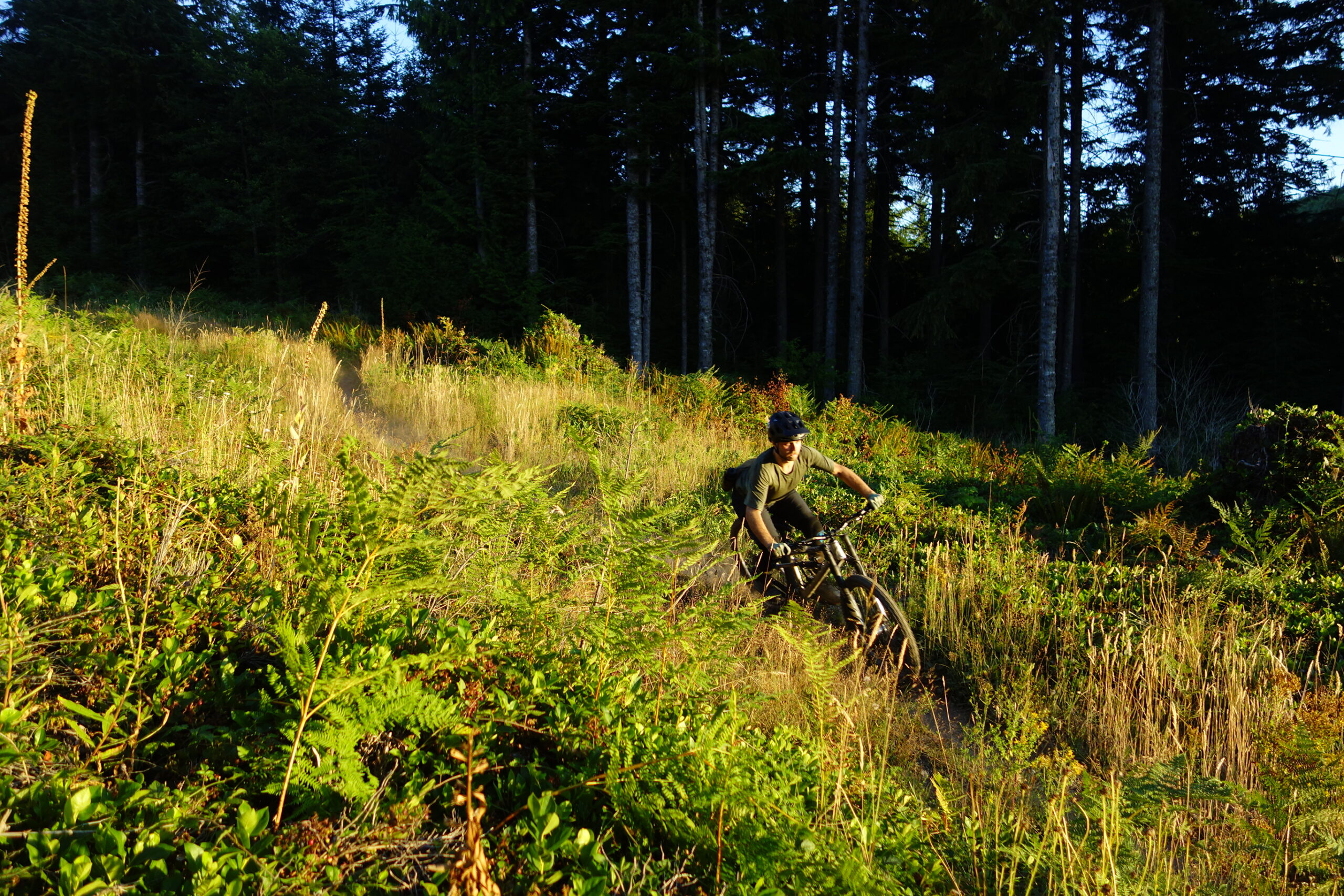
On the Trail
It had been a while since I’d ridden a bike with Hope brakes, and particularly as long-travel 29ers have become more prevalent, their older Tech 3 offerings were starting to feel a bit down on power. Given that, I’m very pleased to report that the Tech 4 V4 is a big step up on that front — they’re now right in the mix with the most powerful Enduro / DH brakes on the market. The V4s are significantly more powerful than the SRAM Code RSC and Shimano XT 4-piston brakes; I think the V4s also have a slight edge over the Hayes Dominion A4, and while they’re probably a small notch behind the Cascade Components North Fork, it’s close. Which is to say that the new V4 is a very, very powerful brake.
Also in keeping with Hope’s claims, the initial lever stroke is relatively light, with a modest amount of force needed to get the brake to its bite point. It’s not as exceptionally so as the Hayes Dominion A4, in particular, but is noticeably lighter than the SRAM Code RSC and Magura MT7 HC3, and similar to or maybe just a touch firmer than the Shimano XT.
Hope also talks a lot about the Tech 4 brakes being designed to have very linear power delivery with the goal of making them easy to modulate, and I’ve found those claims to be accurate, too. There’s lots of power available, but it doesn’t come on as strong from the initial bite as some of its competitors — ServoWave-equipped Shimano brakes, such as XT 4-pistons, in particular — but builds more smoothly and gradually as you build lever pressure.
Whether or not that’s a good thing is going to be down to personal preference; their power delivery makes the V4s notably easy to modulate for a brake with as much outright power as they have, but folks who want a brake that comes on very strong right from the jump might find the V4s to not be the best fit in that regard. And on that note, the bite point on the V4s can feel a little soft when squeezing the brake in the parking lot, but that sensation is greatly mitigated on trail by just how much power the V4s have. Yes, the bite point doesn’t firm up all that dramatically as you pull harder, but the V4s are powerful enough that I rarely find myself pulling on them hard enough that they feel notably soft or spongy.
The lever throw is also not super short — nor is it on any of the most powerful brakes on the market, due to the constraints that I spoke about with Hope engineer Sam Gibbs back in Ep. 122 of Bikes & Big Ideas — but it’s generally in line with the class of brakes that the V4 falls into. Since they all share a lever and only differ in caliper design, the E4 and X2 should both feature slightly shorter throws and firmer bite points than the V4 that I’ve been riding, due to the differences in hydraulic leverage, but we haven’t yet been able to try either of those other variants to compare. I’ve never been inclined to run the contact point adjuster anywhere but at the shortest throw (nor do I tend to on other brakes, either) but the V4s haven’t given me anything to complain about on that front.
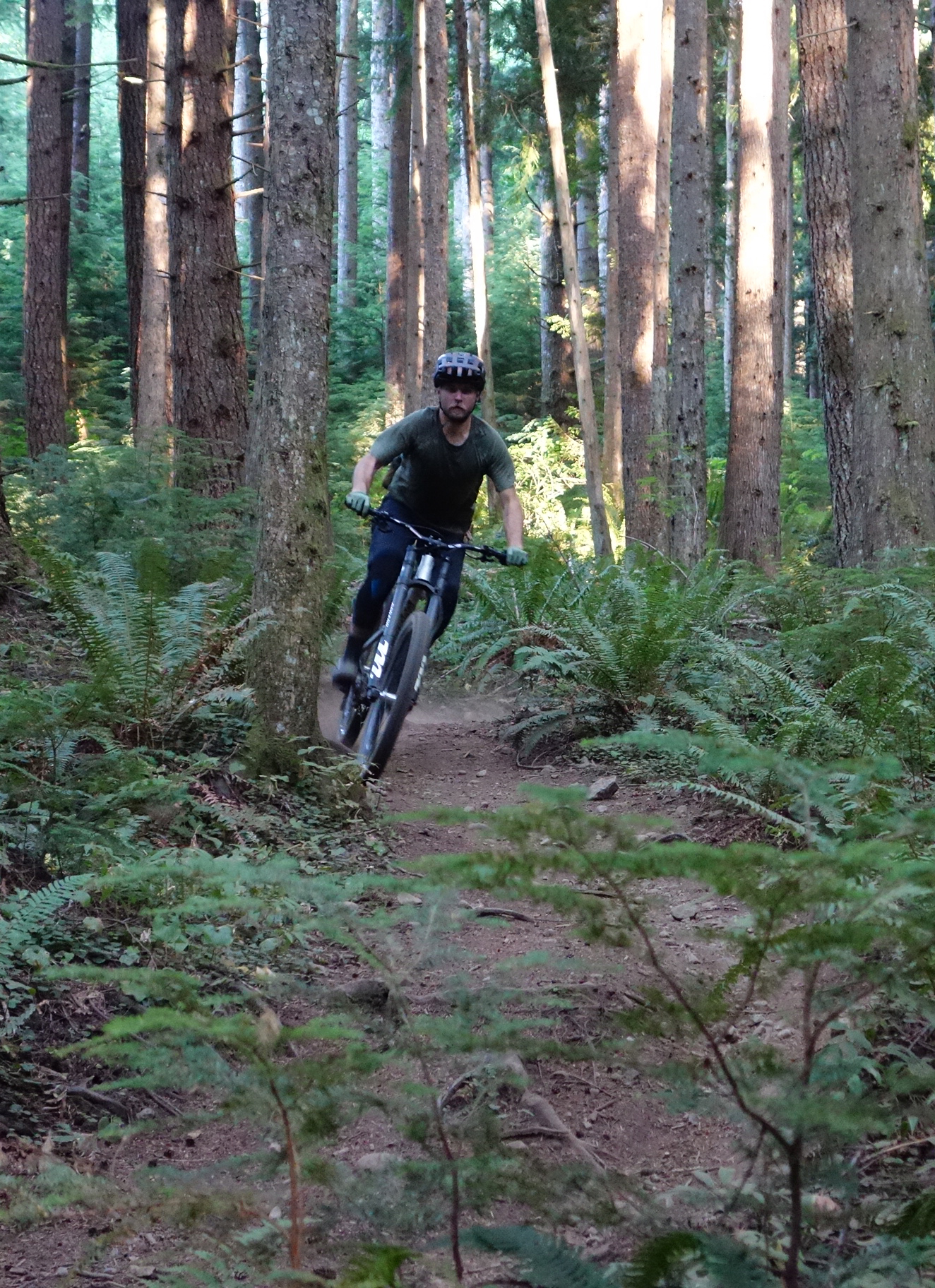
I’ve also been happy with the ergonomics of the Tech 4 lever in general. The initial photos that came out of the new lever lead a lot of folks in certain corners of the mountain bike internet to speculate that the reach on them was going to be huge, or that you’d need super long fingers to operate the brakes, and that’s not the case at all. It’s possible to set up the Tech 4 V4s to bite with the lever essentially touching the grips, and the lever pivot point is at a similar distance from the bar as most of the competitor brakes that I’ve already mentioned. I tend to run my brakes fairly close to the bar — and have complained about certain brakes not accommodating that preference well in the past — but I’ve got a significant amount of room to adjust the Tech 4 lever farther in than my preferred setup. And the reach adjustment range is quite broad — I think very few people will find that the V4s can’t be set out far enough for their liking.
The lever blade itself is on the chunkier, thicker side, with a comparatively large, flat surface and a bunch of dimples for grip. The hook at the end of the lever blade is nicely shaped and has held my figures securely — it feels more pronounced and solid than that of the Tech 3 lever. Folks who prefer a more slim, thin lever blade might find the Tech 4’s to be a bit bulky for their preferences, but I personally find it to be quite comfortable, and to do a better job of distributing pressure than some thinner lever blades, such as the Magura HC3 variant that’s an option on the MT7.
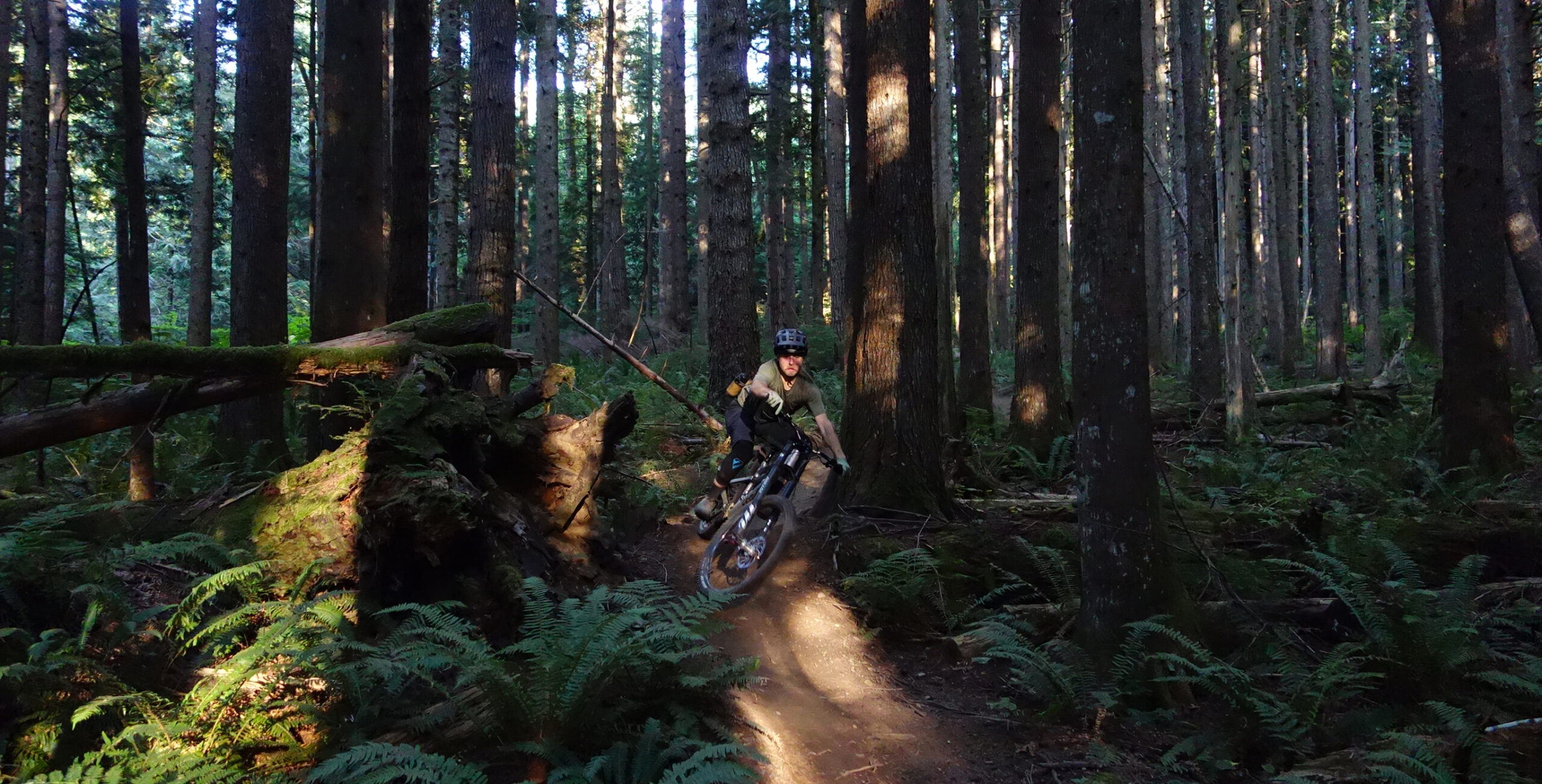
Rotors & Rotor Sizes
I’ve tried the Tech 4 V4s with both dual 203 mm rotors and also with a 220 (Hope) and 223 (Galfer) mm one up front, as an experiment. I didn’t strictly need more power than the 203 mm front rotor had on offer, but (as I’ve discussed a few times recently on Blister) I’ve become pretty sold on the idea that running a slightly more powerful brake than you strictly need is beneficial when it comes to both hand fatigue and, somewhat counterintuitively, brake control, since you don’t need to squeeze as hard to get all the power you need out of the brake, and it’s easier to modulate carefully when you’re not hauling on a brake lever for all you’re worth.
Hope seems to agree, saying “if in doubt always pick the most powerful option — what can do more can do less.” That said, they also rightly note that too large rotors, in particular, can make it hard to get enough heat into the brakes for them to work to their full potential. But I had no such issues with the 220 mm front rotor on my Nicolai G1, and found it to generally be a worthwhile upgrade; on the BTR Ranger, with its smaller 27.5’’ wheels, I was entirely happy with the 203 mm.
Hope’s floating rotors have been around for a long time now, and carry over unchanged to the new Tech 4 line. In my experience (on both the new V4s and earlier brakes), they work well and do an especially good job of avoiding warping under heat, but do tend to make a little bit of a soft warbling noise under hard braking, and can also audibly ping themselves cool, much like a hot car engine, due to the disparate thermal expansion of the stainless steel brake track and the aluminum carrier. I also tried Galfer’s new Shark rotors with the V4, mostly to confirm that the faint noises I was getting out of them were indeed rotor-related, and my suspicions there were confirmed. I’m still happy running the Hope rotors (and honestly find the cooling pinging kind of fun) but folks who are in search of complete silence should probably consider a different rotor option.
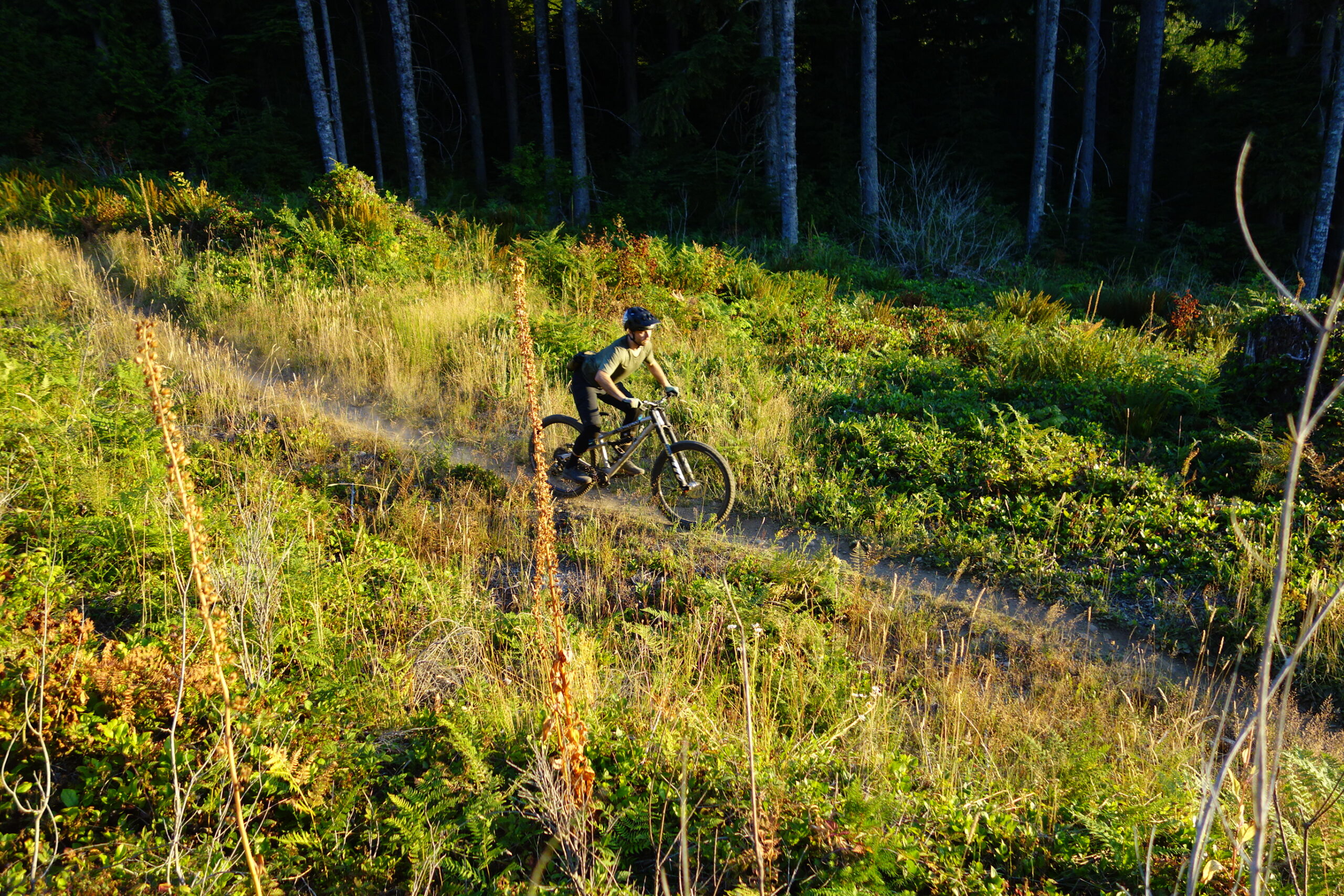
Maintenance
For the most part, the V4s have also been reliable and consistent in my time on them. The initial pair of brakes that Hope sent over were a pre-production model, and they identified a faulty batch of master cylinder seals that had made its way into some of those early models; I hadn’t encountered any major issues at that point, but Hope still sent over a replacement set of brakes plus a new set of seals to get the first set shipshape. It turned out that the new seals did make for a bit firmer lever feel and shorter free stroke, but the brakes were still working reasonably well with the original faulty seals. Both sets have been entirely solid since replacing the seals in the first one, and that particular issue should be resolved on all production brakes at this stage.
Replacing the seals obviously required re-bleeding the brakes, but the process was quite straightforward, and Hope does a commendable job of making spare parts available and their brakes serviceable to keep them running smoothly for a long time. And in an unusual and very cool move, Hope also has made an assortment of small brake service tools that are designed to be 3D printed and provided the files free of charge for folks with the ability to do so to print their own.
I did find getting a good bleed on the V4s to be a little tougher than on some other brakes. The procedure isn’t complicated or difficult, but it took a couple of tries to get every last air bubble out. Once I achieved a good bleed, the V4s have been very consistent and reliable, and haven’t needed further attention, but getting there initially was more time-consuming than I might have hoped for. To be fair, I was doing the bleeding without the benefit of the full Hope bleed kit and funnel at the reservoir, though doing it without doesn’t fundamentally change the process; you just need to be more careful to top off the reservoir more frequently.
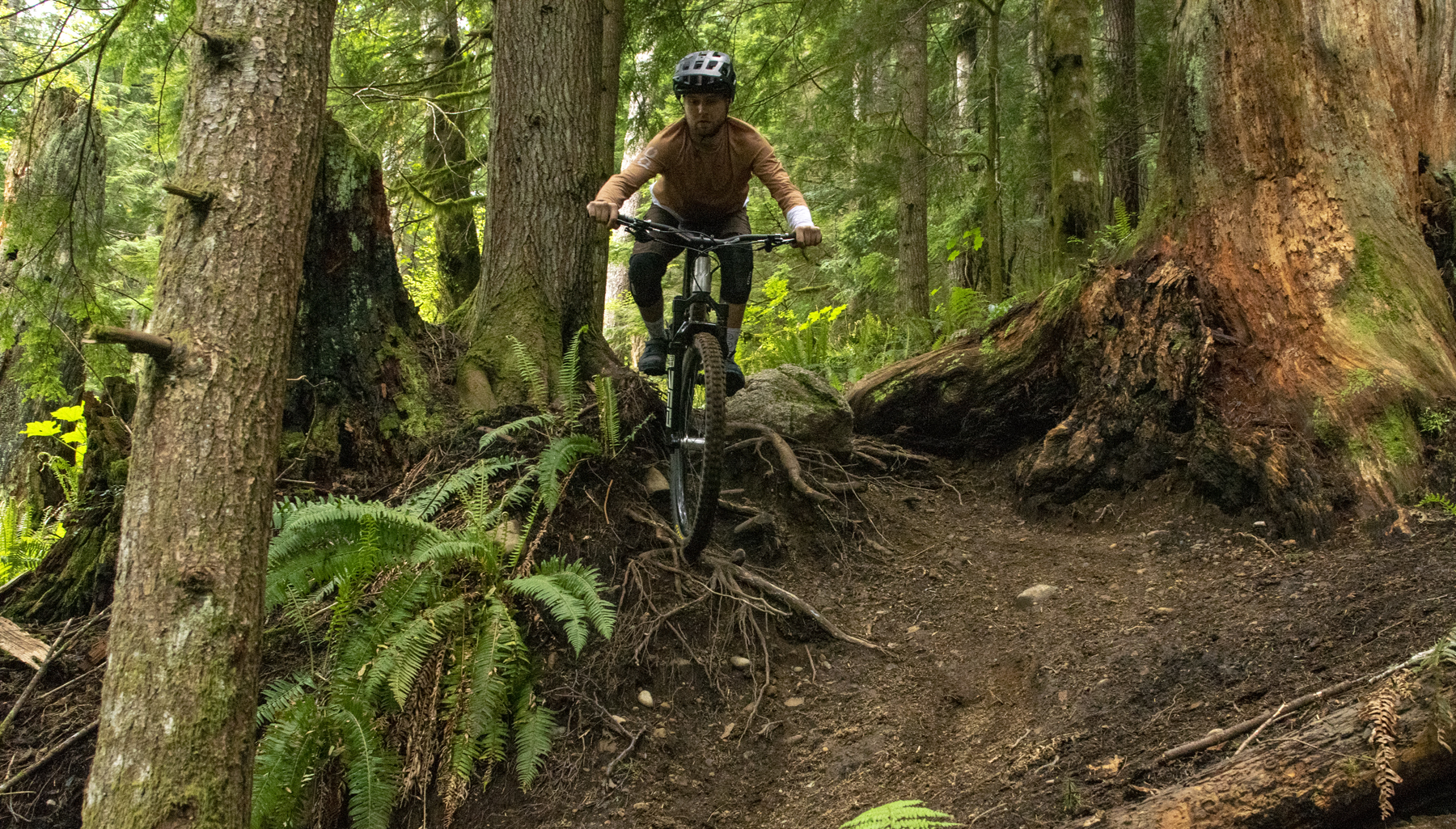
Brake Pads
My testing of the pad compound options is somewhat incomplete at this point, both because testing brake pads just takes a long time to assess durability, and because it’s been extremely dry of late and I’ve had few opportunities to test wet-weather performance. In the interest of getting the initial review out, I’ve mostly focused on Hope’s standard Racing pads thus far but will spend some more time using the other options and run an update with more comparisons down the line.
What I can say at this point is that Hope’s green Racing pads are quite impressive — raw power is excellent, their fade resistance is good, and they’ve been relatively quiet and plenty consistent in my time on them. My early take on their wet-weather performance is that it’s respectable, but not as outstanding as Galfer’s Pro pads (interestingly, Galfer is the supplier of all of Hope’s brake pad variants except for the Racing versions). But I’ll do some more direct A/B testing once the rains return this fall and report back.
Unsurprisingly, the tradeoff for that excellent performance is that the Racing versions are not the most durable pads out there, but it’s not like I’ve been blowing through them at a crazy clip or anything — the initial stock set is getting down there, but still have some life left after about 4.5 months of testing. Their power is a notable tick up from Hope’s red “All Conditions” pads — not a night-and-day difference or anything like that, but noticeable. Hope says that the All Conditions pads are both more durable and perform better in the wet, at the expense of a bit of power and a little heat resistance; you can see their brake pad selection guide for a more complete rundown, and I’ll have an update with my own take later this year.
Bottom Line
The Hope Tech 4 V4 brakes get a big bump in power compared to the Tech 3 generation that they replace, and feel like a true modern Enduro/DH brake on that front. In particular, they’re a great choice for riders who want a lot of power, paired with a light lever throw, linear power delivery, and easy modulation. Their bite point isn’t the most firmly defined, and riders who prefer a super sharp, aggressive initial bite might find the V4s to feel a little soft. But if you like the sound of that sort of lever feel and are looking for a very powerful brake, their performance is very, very good.
And stay tuned for our upcoming brake shootout — which we touch on in Ep. 132 of Bikes & Big Ideas — that’ll offer an in-depth comparison of how the Tech 4 V4s stack up to a whole lot of their competitors, coming later this year.

Great review! How do the V4’s compare to the Dominion A4 and TRP DHR Evo brakes when it comes to overall power, bite point, lever feel & lever throw? I feel like I have to pull my Code RSC’s so hard to get full braking power and they fade on long descents (200/200mm rotors).
As is always the case – great review.
Curious on the Shark vs Hope rotor comparison. As I’m building up a new brake set for my DH rig, I’m looking at the shark rotor option possibly with Glalfer pro’s vs the Hope greens OR stay with the Hope rotors.
I’m not sure I can go wrong with either but I am interested to see how these setup vs my M9120 synco / Shimgura setup with pro greens.
Hi,
Did you experience high pitch noise with the Hope tech4 v4s?
I’ve had the issue that every time I break I get the high pitch noise. It’s louder on dry conditions. I’ve tried six sets of brake pads and total of 5 rotors (Hope,TRP, Galfer) + every possible trick. I found many other people with same problems on the forums and you could hear which guys were using hopes on this year’s rampage.
I’ve ridden the Hope brakes for ~200h mostly downhill and I’m going to replace them with propably Hayes dominions.